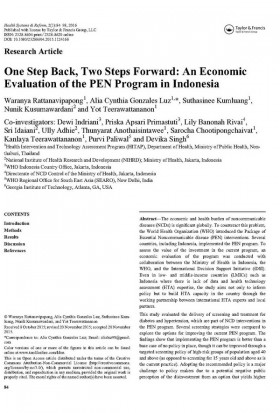This website uses cookies so that we can provide you with the best user experience possible. Cookie information is stored in your browser and performs functions such as recognising you when you return to our website and helping our team to understand which sections of the website you find most interesting and useful.
One Step Back, Two Steps Forward: An Economic Evaluation of the PEN Program in Indonesia (2016)

Details
Waranya Rattanavipapong1, Alia Cynthia Gonzales Luz1,*, Suthasinee Kumluang1,Nunik Kusumawardani2 and Yot Teerawattananon1
Co-investigators: Dewi Indriani3, Priska Apsari Primastuti3, Lily Banonah Rivai4,
Sri Idaiani2, Ully Adhie2, Thunyarat Anothaisintawee1, Sarocha Chootipongchaivat1,
Kanlaya Teerawattananon1, Purvi Paliwal5 and Devika Singh6
1Health Intervention and Technology Assessment Program (HITAP), Department of Health, Ministry of Public Health, Nonthaburi,
Thailand
2National Institute of Health Research and Development (NIHRD); Ministry of Health, Jakarta, Indonesia
3WHO Indonesia Country Office, Jakarta, Indonesia
4Directorate of NCD Control of the Ministry of Health, Jakarta, Indonesia
5WHO Regional Office for South East Asia (SEARO), New Delhi, India
6Georgia Institute of Technology, Atlanta, GA, USA
Abstract—The economic and health burden of noncommunicable diseases (NCDs) is significant globally. To counteract this problem, the World Health Organization (WHO) introduced the Package of Essential Noncommunicable disease (PEN) interventions. Several countries, including Indonesia, implemented the PEN program. To assess the value of the investment in the current program, an economic evaluation of the program was conducted with collaboration between the Ministry of Health in Indonesia, the WHO, and the International Decision Support Initiative (iDSI). Even in low- and middle-income countries (LMICs) such as Indonesia where there is lack of data and health technology assessment (HTA) expertise, the study aims not only to inform policy but to build HTA capacity in the country through the working partnership between international HTA experts and local partners.
This study evaluated the delivery of screening and treatment for diabetes and hypertension, which are part of NCD interventions in the PEN program. Several screening strategies were compared to explore the options for improving the current PEN program. The findings show that implementing the PEN program is better than a base case of no policy in place, though it can be improved through a targeted screening policy of high-risk groups of population aged 40 and above (as opposed to screening for 15 years old and above as is the current practice). Adopting the recommended policy is a major challenge to policy makers due to a potential negative public perception of the disinvestment from an option that yields higher health outcomes. However, this study demonstrates that with the same budget currently invested in the program, the changes proposed will result in improvements on the current low uptake and poor coverage, thus yielding cost savings for the government and a possibility to reallocate resources to the country’s priority health concerns, consequently leading to better health outcomes.
Full Text: http://www.tandfonline.com/doi/full/10.1080/23288604.2015.1124168




